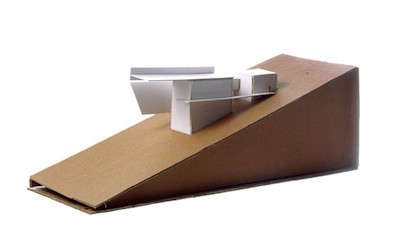If This House Could Write a Book, If This Book Could Build a House…

Matt Pericoli, a creative writing professor, teaches a course called the “Laboratory of Literary Architecture,” which includes an assignment to “physically build the literary architecture of a text.” The Times excerpted from his students’ work last week, and the results are fascinating. Here’s Pericoli describing the project:
Each student brings to class a novel, a short story or an essay whose inner workings he or she knows intimately. We start with the plot, the subject or simply a feeling that the student has about the text. We break the piece of writing down into its most basic elements and analyze the relationship of each part to the overall structure, making sure to avoid any literal translations of the text — for example, a specific building or setting.
The exercise is a process of reduction. In architecture, once you remove the skin — the “language” of walls, ceilings and slabs — all that remains is sheer space. In writing, once you discard language itself, the actual words, what’s left? Thus we also work toward the questions that architects, knowingly or unknowingly, must always address: how does one design and build using emptiness as a construction material? How do we perceive space? And how does it affect us?
And from Catherine Pond, a poetry student who built Virginia Woolf’s To the Lighthouse:
The three sections of my model (the first house, the breezeway, the final house) represent the three sections in “To the Lighthouse” by Virginia Woolf. The negative space (the passageway between the two houses, the shadow under the extended roof off the second building) symbolizes Mrs. Ramsay’s death, while the retaining wall on the right side, with its sharp edges, registers the void against something solid. As in the novel, I wanted the physical structure to show that grief and desire should be inextricable.
The Woolf reconstruction is pictured above, but go check them all out at the Times, where, for example, you can toggle the view on David Foster Wallace’s “A Supposedly Fun Thing I’ll Never Do Again.”